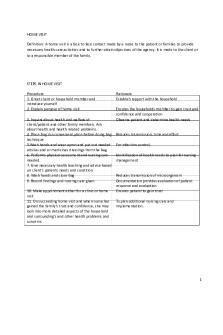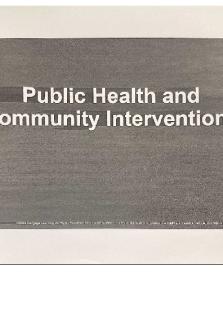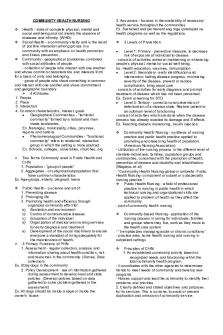Public Health Bag Technique in Community Health Nursing PDF

| Title | Public Health Bag Technique in Community Health Nursing |
|---|---|
| Course | BS Nursing |
| Institution | Mindanao State University |
| Pages | 9 |
| File Size | 269.5 KB |
| File Type | |
| Total Downloads | 17 |
| Total Views | 151 |
Summary
this includes the principles, guidelines, purposes and objective about the health bag technique in which it is one of the important protocol in home visits....
Description
Name: Hadassah Sulamith T. Labrador BSNI-II Community Health Nursing Bag Technique I.
Purpose
The purpose of the bag technique is to enable the nurse to perform a nursing procedure to save time and effort and also to prevent and minimize the spread of infection during the visit of the nurse in the community. II.
Principles Performing the bag technique will minimize, if not, will prevent the spread of any infection.
It saves time and effort in the performance of nursing procedures.
The bag technique can be performed in a variety of ways depending on the agency’s policy, the home situation, or as long as principles of avoiding transfer of infection is always observed.
III.
Contents of the Bag
The bag contains the basic fundamental, essential and indispensable equipment of a nurse in which a nurse carries during the conduct of his or her home visits. The bag gives and offer an immediate access to infection control supplies such as the following;
Paper lining - is a wall covering that is similar to wallpaper but has been designed to be used underneath paint or wallpaper for a smoother finish.
Extra paper for making waste bag is a disposable bag used to contain solid waste
Plastic/linen lining - commonly referred to as poly liners, are flexible plastic liners specifically designed to line the inside of a flexible intermediate bulk container.
Apron - a protective or decorative garment worn over the front of one's clothes and tied at the back
Hand towel - a piece of thick absorbent cloth or paper used for drying oneself or wiping things dry.
Soap in a soap dish - platform where a bar of soap may be placed to dry after use.
Thermometers (oral and rectal) - an instrument for measuring and indicating temperature
2 pairs of scissors (surgical and bandage) - surgical scissors are used to cut soft tissue. While bandage scissors are used for dressings, drapes.
2 pairs of forceps (curved and straight) - Forceps are a medical tool that resemble large salad tongs.
Disposable syringes with needles (g. 23 & 25) - A syringe is a simple reciprocating pump consisting of a plunger that fits tightly within a cylindrical tube called a barrel.
Hypodermic
needles
(g.
hollow needle commonly
19,
used
22, with
23,
25)
-
a syringe to
substances into the body or extract fluids from it.
s
a
inject
Sterile dressing - is a form of absorbent cotton fabric that is generally bonded on both sides so that it does not stick to the wound or area.
Cotton balls - Cotton pads are pads made of cotton which are used for medical or cosmetic purposes.
Cord clamp - the cord is clamped and cut close to the navel. The clamp helps stop bleeding from the blood vessels in the umbilical cord.
Micropore
plaster
-
Commonly used
to secure
bandages and dressings to skin without leaving a sticky residue, micropore paper tape is hypoallergenic and can be used long-term, without fear of skin irritation.
Tape measure - a length of tape or thin flexible metal, marked at intervals for measuring.
1
pair
of
sterile
gloves
-
are
defined
as sterile when they meet the FDA standards for sterilization techniques.
Baby’s scale- baby weighing scale is used during this process to weigh the new-born to give their birth-weight
Alcohol lamp - is a piece of laboratory equipment used to produce an open flame.
2 test tubes - a thin glass tube closed at one end, used to hold small amounts of material for laboratory testing or experiments.
Test tube holders - is used to hold test tubes.
Solutions of: o Betadine - contains the active ingredient povidone-iodine (PVP-I), to help treat and prevent infection in minor cuts, scrapes and burns. o 70% alcohol - kills organisms by denaturing their proteins. o Zephiran solution - Chloride is an antiseptic solution used to cleanse the skin after minor scrapes, cuts and burns. o Hydrogen peroxide - is a mild antiseptic used on the skin to prevent infection of minor cuts, scrapes, and burns. o Spirit of ammonia - to prevent or treat fainting. o Ophthalmic ointment - This medication is used to treat eye infections. o Acetic acid - the acid that gives vinegar its characteristic taste. The pure acid is a colorless viscous liquid or glassy solid. o Benedict’s solution - (Fehling's solution) is used to test for simple sugars such as glucose. It is a clear blue solution which is a combination of copper sulfate, sodium citrate, and sodium carbonate.
Note that a BP apparatus and stethoscope are carried separately and are never placed in the bag. These are the things that a Public Health Bag contains in which it can be use and necessary whenever a community nurses are giving care.
IV.
Proper Placements of Contents
A. Front of the Bag (left to right)
Oral thermometer (facing down)
Rectal Thermometer
Syringes & Needles in a metal container
B. Right side of the Bag
Test Tube & Test Tube Holder
Medicine Dropper
Match
Alcohol lamp & Denatured Alcohol
C. Left Side of the Bag (near to the front)
Medicine glass with suction inside
Baby weighing scale
D. Back of the Bag (Left to right)
Betadine
70% alcohol
Hydrogen Peroxide
Spirit of Ammonia
Benedict’s solution
E. Center of the Bag
Kidney Basin
Cloth Bag
Umbilical Scissors
Bandages
Cloth bag with sterile OS (Operating Sponge), cotton balls, Cotton Applicators
Hand towel
Soap dish and Soap
Apron
F. Top Pocket
Sterile Gloves
French 12 Catheter
French 8 Catheter
Cord Clamp
Paper waste bags
Plastic bag
G. Top of the Inner Cover
V.
5’ – 8’ Paper soap dish
12 ½ - 18 ½ paper lining
13½ - 19½ plastic lining
14 – 20 paper lining- for the bottom
STEPS with Rationale
1. Upon arriving at the client’s home, place the bag on the table or any flat surface lined with paper lining, clean side out (folded part touching the table). Put the bag’s handles or strap beneath the bag. To protect the bag from contamination. 2. Ask for a basin of water and a glass of water if faucet is not available. Place these
outside
the
work
area.
To
be
used
for
handwashing.
To protect the work field from being wet. 3. Open the bag, take the linen/plastic lining and spread over work field or area. The paper lining, clean side out (folded part out). To make a noncontaminated work field or area. 4. Take out hand towel, soap dish and apron and the place them at one corner of the work area (within the confines of the linen/plastic lining). To prepare for handwashing. 5. Do handwashing. Wipe, dry with towel. Leave the plastic wrappers of the towel in a soap dish in the bag. Handwashing prevents possible infection from one care provider to the client. 6. Put on apron right side out and wrong side with crease touching the body, sliding the head into the neck strap. Neatly tie the straps at the back. To protect the
nurses’ uniform. Keeping
the
crease
creates aesthetic
appearance. 7. Put out things most needed for the specific case (e.g.) thermometer, kidney basin, cotton ball, waste paper bag) and place at one corner of the work area. To make them readily accessible.
8. Place waste paper bag outside of work area. To prevent contamination of clean area. 9. Close the bag. To give comfort and security, maintain personal hygiene and hasten recovery. 10.Proceed to the specific nursing care or treatment. To prevent contamination of bag and contents. 11. After completing nursing care or treatment, clean and alcoholize the things used. To protect caregiver and prevent spread of infection to others. 12.Do handwashing again. To prevent contaminations and infections. 13.Open the bag and put back all articles in their proper places. To maintain the cleanliness, efficiency and orderliness of the equipment. 14.Remove apron folding away from the body, with soiled side folded inwards, and the clean side out. Place it in the bag. To prevent contamination and infections. 15.Fold the linen/plastic lining, clean; place it in the bag and close the bag. To keep linen organized inside the bag. 16.Make post-visit conference on matters relevant to health care, taking anecdotal notes preparatory to final reporting. To be used as reference for future visit. 17.Make appointment for the next visit (either home or clinic), taking note of the date, time and purpose. For follow-up care.
VI.
General Considerations
1.
Staff is responsible for maintaining the cleanliness and completeness of the bag.
2.
As homes differ greatly, staff will need to use judgment in selecting an
appropriate work area. Considerations include: cleanliness of home, adequate lighting, low traffic area, away from direct currents from windows, heat or air conditioning 3.
vents,
safe
area
for
bag
away
from
pets
and
children.
Bag must be thoroughly cleaned if soiled and periodically as needed. Reusable
equipment is cleaned with soap and water in the presence of bodily secretions, dried,
then
wiped
4.
Disposable
with equipment
alcohol is
and used
allowed
to
whenever
air
dry.
possible.
5.
Patient’s equipment (e.g., thermometer, BP unit) is used whenever possible.
6.
The inside and contents of the bag are always considered clean. VII.
•
Nursing Considerations
Instruct the patient/caregiver on infection control precautions and on how to
reduce •
risk
of
transmitting
a
communicable
disease.
Consider referring patients who have active infectious organisms, such as
vancomycin-resistant Staphylococcus aureus, to “infectious disease clinic” or specific case manager to reduce the risk of staff exposure and transmission of infectious organisms • •
Try
to to
visit
these
other
patients
last
or
at
patients. the
end
of
the
day.
When possible, use disposable equipment or keep needed equipment in the
home with these patients, and contact the local health department for further surveillance/management guidelines. VIII.
Documentation Guidelines •
Any
patient/caregiver
precautions
and
instructions
response
to
regarding
teaching,
infection
including
control
adherence
to
recommendations •
Implementation
•
Physician
•
Other
of notification,
Standard
Precautions.
if
applicable
pertinent
findings.
*Update the plan of care. IX.
Reflection
Serving in the community as a Community Health Nurse isn’t as piece of cake. It focuses about health promotions and disease prevention. In which, nurses have to carry bags that has been a vital tool to carry also the equipment necessary in performing nursing procedures outside laboratory or in the community. The bag technique helps nurses to work or perform nursing procedure efficiently, for the reason that it already contains necessary equipment during the conduct of home and community visitation. A bag and its equipment inside must be organized neatly and completely in order to promote work, efficiently and also it helps nurses to save effort and time. Nurses are accountable in handling their bag containing the
equipment necessary for the community and also nurses have to consider things such as; the orderliness of the bag, the cleanliness of the bag and of the equipment in order to prevent infections and contaminations of diseases and bacteria, the completeness off the equipment and the appropriate work area. It has always been a great challenge for the Community Health Nurses the work place in terms of the cleanliness and safe areas for bags away from pets and children. Equipment inside the bag will no longer be considered clean if it is exposed for the reason of, it has been included in the General considerations that “everything that is inside the bag is considered clean.”
Nurses should also mind always the
nursing considerations in order to maintain the advocacy in which is to maintain the cleanliness and to prevent the spread the infections, diseases and microorganisms.
Resources https://nurseslabs.com/home-visits-bag-technique/ https://www.scribd.com/doc/47836314/CHN-Bag https://www.rnpedia.com/nursing-notes/community-health-nursing-notes/bagtechnique/ https://www.nursingald.com/articles/19975-proper-bag-technique...
Similar Free PDFs

Community Health Nursing RLE
- 15 Pages

Community Health Nursing Kaplan
- 41 Pages

COMMUNITY HEALTH NURSING NOTES
- 2 Pages

Community Health Nursing NCM 113
- 5 Pages

BAG- Technique - RLE Bag
- 7 Pages
Popular Institutions
- Tinajero National High School - Annex
- Politeknik Caltex Riau
- Yokohama City University
- SGT University
- University of Al-Qadisiyah
- Divine Word College of Vigan
- Techniek College Rotterdam
- Universidade de Santiago
- Universiti Teknologi MARA Cawangan Johor Kampus Pasir Gudang
- Poltekkes Kemenkes Yogyakarta
- Baguio City National High School
- Colegio san marcos
- preparatoria uno
- Centro de Bachillerato Tecnológico Industrial y de Servicios No. 107
- Dalian Maritime University
- Quang Trung Secondary School
- Colegio Tecnológico en Informática
- Corporación Regional de Educación Superior
- Grupo CEDVA
- Dar Al Uloom University
- Centro de Estudios Preuniversitarios de la Universidad Nacional de Ingeniería
- 上智大学
- Aakash International School, Nuna Majara
- San Felipe Neri Catholic School
- Kang Chiao International School - New Taipei City
- Misamis Occidental National High School
- Institución Educativa Escuela Normal Juan Ladrilleros
- Kolehiyo ng Pantukan
- Batanes State College
- Instituto Continental
- Sekolah Menengah Kejuruan Kesehatan Kaltara (Tarakan)
- Colegio de La Inmaculada Concepcion - Cebu










